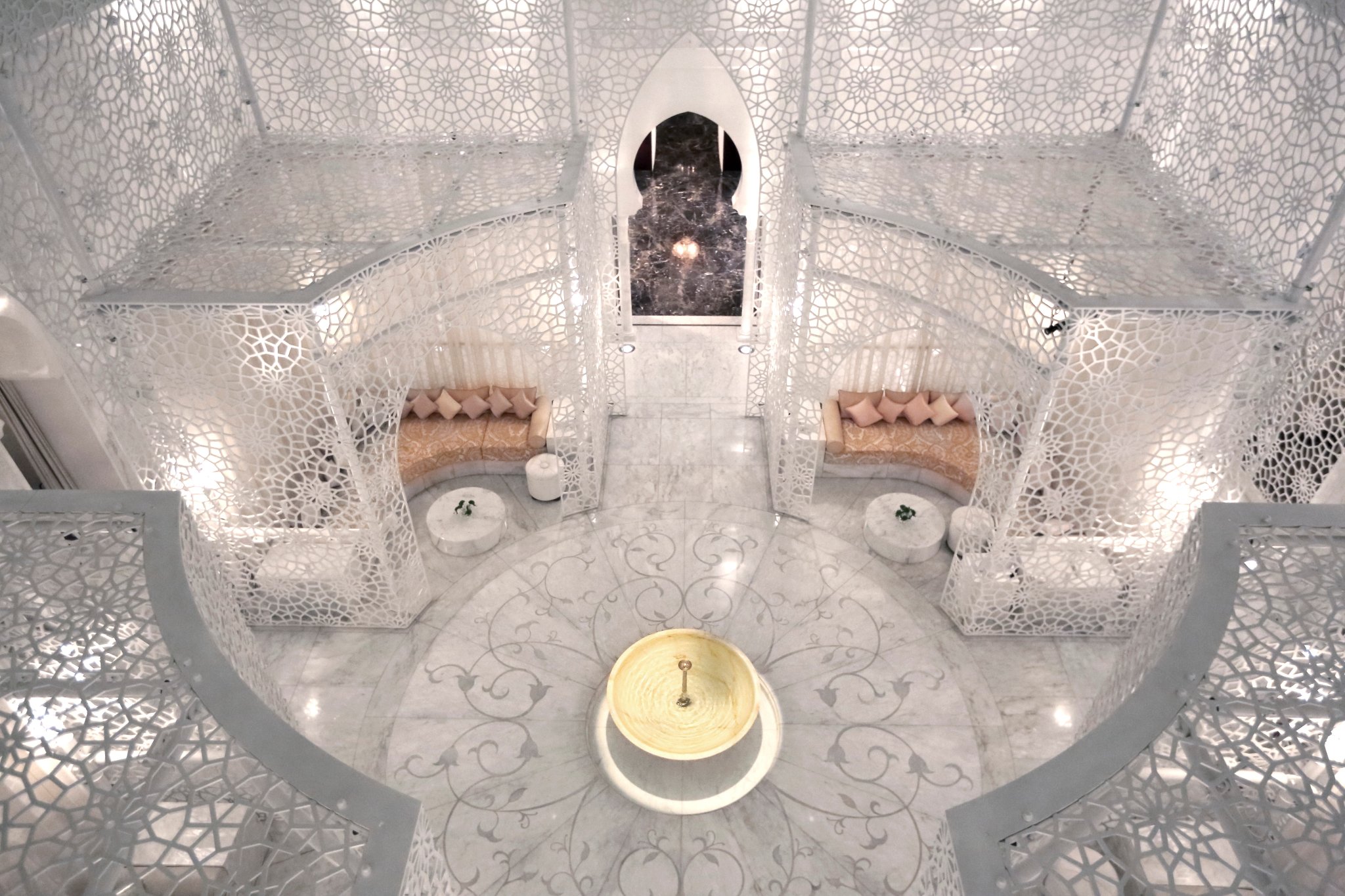We may earn revenue from the products available on this page and participate in affiliate programs.
It was around the time I was getting doused repeatedly with hot water—laying on a marble bench affixed to the wall, naked except for a pair of disposable underwear—that my heart rate slowed down and I finally started to relax. I was about halfway into my first-ever hammam treatment at the Royal Mansour in Marrakech, a fantasy of a hotel dreamed up by Morocco’s King Mohammed VI.
The property is famous for its gorgeous 20,000 square-foot all-white spa adorned with traditional Moucharabieh-carved wooden lattices. My treatment therapist, Hinde, had already applied the black soap made with olive oil and vetiver, which prepares the skin for exfoliation, and used a Kessa glove to scrub off the dead skin. Between every step in the ritual—the black soap, scrubs, masks, and lotions—Hinde took a silver bucket and doused me with hot water that splashed everywhere and flowed onto the floor of the little marble room.
At the beginning of the treatment, I found it difficult to unwind because I didn’t know what to expect. I’d heard things from friends who had visited Morocco and read articles about where to find the best hammams in Marrakech, but I still had nagging questions in my head about how the treatment would unfold. I knew that I would have to be naked, which gave me pause. It took me years to stop caring about what my body looks like in a swimsuit, so stripping down in front of a stranger was something I would normally avoid at all costs. But I didn’t want to pass up the opportunity to try this traditional spa treatment while I was in Marrakech.

“When you come to Morocco, you must experience this,” explains Malika Rojhani, the incoming spa director at the Royal Mansour. “Like when you go to Bangkok, you must experience the Thai massage. When you go to Japan, you must experience the Shiatsu massage. It’s our unique treatment, and for our spa, it’s our signature.”
As Rojhani explains it, Moroccan hammams can be traced back to the ancient Roman baths. The Romans, however, didn’t exfoliate but would go to the baths to relax and soak as a social activity, much the way Moroccans do. My therapist, Hinde, told me that she goes to the hammam on a weekly basis, and Rojhani confirmed that many Moroccans go once a week on Sundays. According to Rojhani, the ritual aspect of the hammam originates with the Andalusians and the Muslims, who would cleanse themselves on Fridays before praying.

These days, the hammam may have lost its religious connotations, but it’s still considered a social activity. Normally, when you go to a hammam in Morocco, you’re in a group room where everyone washes either seated on a bench or directly on a heated floor. Shy people like myself, however, can have a private hammam treatment in one of the Royal Mansour’s spa suites. It’s also typically acceptable to wear bikini bottoms. If you venture outside of your hotel, facilities can range widely between inexpensive, average, and upscale.

“In many parts of the Arab world, especially outside of North Africa, the culture of the Moroccan or Turkish bath has largely faded out, so that’s something that makes Morocco special,” says Elizabeth Guthrie, a professor of Arabic Studies at the Catholic University of America in Washington DC.
Professor Guthrie, who has lived in Tunisia and Jordan and organized study abroad programs in Morocco, has visited a wide range of hammams in cities including Marrakech, Rabat, and Fez. “Tunisia has some baths, but it’s not a widespread part of the culture and it’s not as well known,” she explains. “In Morocco, it’s something ordinary people do, but they often go to the posher ones before weddings or ceremonies.”

The treatment begins in the hot room, where you rinse yourself (or, as in my case, your treatment therapist rinses you) with hot water and you get scrubbed with black soap, which is really more of a balm than a typical bar of soap. You then go to the warm room, where the therapist exfoliates your skin by making circular motions with a rough Kessa glove that scrapes off the dead skin. It feels a bit like having a massage aided by sandpaper, though not in an unpleasant way. Then your therapist applies a body wrap, which, in the Royal Mansour’s case, is made with natural ingredients like roses from the Kalaat M’gouna Valley, clay from the Atlas Mountains, and saffron from the area around Ouarzazate. The therapist also washes your hair with argan oil or olive oil mixed with herbs. At the end of the treatment, you take a plunge in a cold pool, which closes your pores, balances your circulation, and firms your skin.
“You purify your skin, which is good because you take off all the dead skin. You detoxify your skin because when you are in the heated room, you will sweat and when you sweat, you take off all the toxins,” Rojhani says. “After that, you exfoliate. The exfoliation takes off all the impurities of your skin. When you finish, you’ll have smooth, radiant, soft skin.”
After my plunge in the cold pool, I put on a robe, laid down to rest, and ended up dozing off a bit. I couldn’t help marveling at how soft my skin felt. I’d never seen it so radiant in my life. If I could, I would go once a week too.
